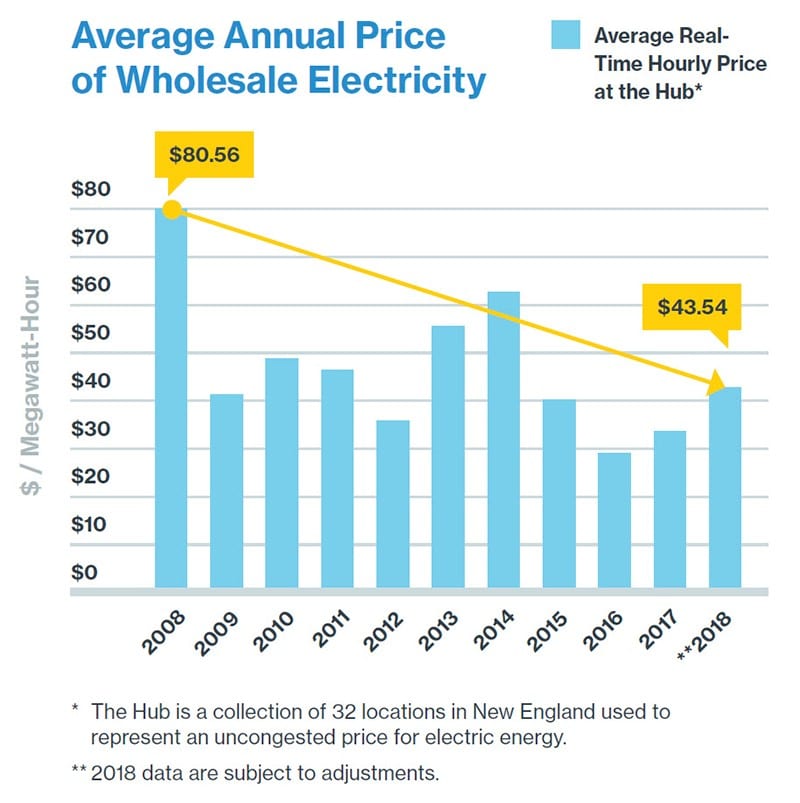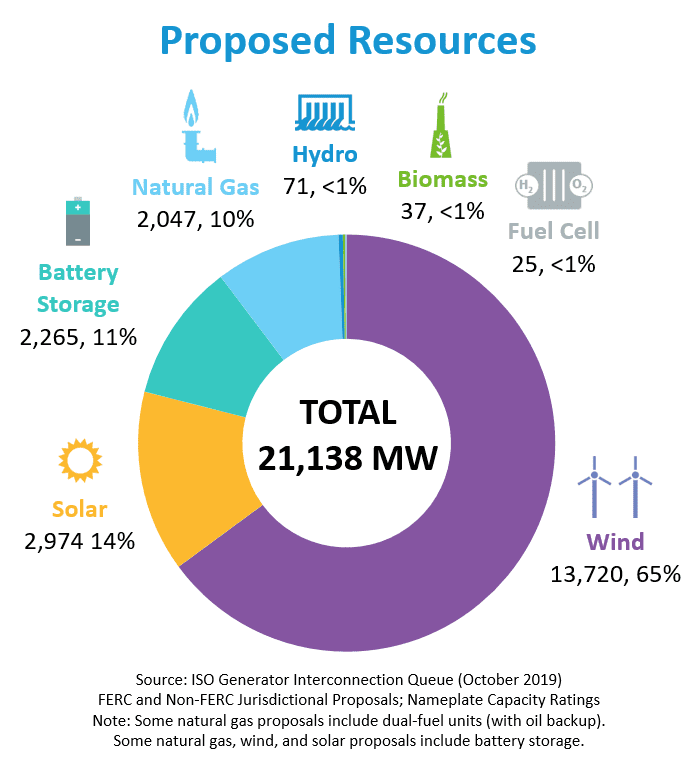Greening the grid: New England’s technology-neutral wholesale electricity markets have led to cleaner, lower-cost power for the region

 ISO-NE continues to develop solutions that help the New England states achieve their clean energy goal while keeping the markets competitive
ISO-NE continues to develop solutions that help the New England states achieve their clean energy goal while keeping the markets competitive
Addressing climate change is a top priority for the New England states, and the issues at play are complex. Recently, a lot of activity and conversation has emerged on what ISO New England’s role should be in helping the states fulfill their clean energy policies. Numerous parties are involved in these discussions—many who are not familiar with the ISO—and occasionally our role is misunderstood. It is important to remember that ISO New England does not set policy and does not control the mix of resources being developed in the region.
The electricity industry was restructured more than 20 years ago driven by state and federal initiatives. The goal was to move away from vertically-integrated, rate-payer-funded utilities that controlled how the grid developed, and to introduce open, competitive wholesale markets that would provide the least-cost, reliable wholesale electricity supply for consumers, regardless of the fuel or technology used to generate the electricity. ISO New England was created as the independent administrator of the region’s wholesale electricity markets and is duty-bound by its regulator, the Federal Energy Regulatory Commission, to open the highly competitive markets to all resources.
Over two decades, this approach has resulted in cleaner, more reliable, and lower-cost wholesale electric power for the region. This is evidenced in:
 The development of a new, more efficient power fleet in New England. When the markets opened to competition, private investors pursued the development of natural-gas-fired power plants because they met state environmental policies, were relatively inexpensive to build, were easier to site, and had access to low-cost, nearby shale gas.
The development of a new, more efficient power fleet in New England. When the markets opened to competition, private investors pursued the development of natural-gas-fired power plants because they met state environmental policies, were relatively inexpensive to build, were easier to site, and had access to low-cost, nearby shale gas.

- The decrease in wholesale electricity prices. Markets reveal a resource’s true operating cost and the primary driver of operating costs is fuel. As lower-cost natural gas plants displaced older oil and coal plants, wholesale electricity prices declined.
- The significant drop in greenhouse gas emissions (GHG) due to the rise of efficient resources that use natural gas.
- The rapid growth in energy efficiency—driven by state policies and wholesale market revenues, which reduced not only the demand for electricity, but also the need to turn on the most expensive power plants.
 Strong interest by developers of new resources seeking to participate in New England’s wholesale markets. The majority of resources currently proposed for the region are wind, solar, and battery projects, with natural-gas-fired power plants in the minority. Driven by state clean-energy initiatives, developers of clean energy resources are also likely to seek revenue from the wholesale markets to augment state incentives.
Strong interest by developers of new resources seeking to participate in New England’s wholesale markets. The majority of resources currently proposed for the region are wind, solar, and battery projects, with natural-gas-fired power plants in the minority. Driven by state clean-energy initiatives, developers of clean energy resources are also likely to seek revenue from the wholesale markets to augment state incentives.
Today, many of the New England states are focused on further reducing GHG emissions from the power grid. ISO New England has said that putting a price on carbon is the most efficient way to reduce GHG emissions within the competitive market structure. However, the New England state policymakers and other stakeholders who would be responsible for putting this approach in motion have not pursued this option and instead have chosen a different path outside of the wholesale markets. At varying levels and speed, New England states are promoting the development of specific clean-energy resources through ratepayer-funded programs in order to decrease GHG emissions in their states.
In response, the ISO has been working steadily and intensively with all regional stakeholders, with their differing interests, to refine and enhance the markets to reliably incorporate the resources being developed through state clean-energy initiatives, while maintaining the integrity of the region’s competitive markets. In other words, the ISO is developing solutions that help the states achieve their goals without harming the region’s competitive markets that have been serving the region well to date.
In fact, ISO New England has already made great strides to get the grid ready for the future—one in which clean-energy resources will be the primary resource used to reliably meet consumer demand. Below is a list of initiatives the ISO has implemented over the past eight years to attract, integrate, and plan for energy efficiency and demand-response resources, energy storage, wind, and solar developments—both large-scale and behind the meter (learn more in the 2019 Regional Electricity Outlook).
Again, understanding the ISO’s role, responsibilities, and limitations on what it can and cannot do will enable a more productive discussion of paths toward New England’s decarbonization efforts in the power system and across the economy. ISO New England will continue working with our partners in the states and industry to ensure the residents and businesses of New England have access to reliable, clean, competitively-priced electricity.
The ISO has adapted its markets, operations, and planning to prepare for the grid of the future
Predicting the Unpredictable: Continuous Forecasting Enhancements
- 2012: Multi-state, long-term energy-efficiency forecast
- 2013: Hourly wind forecasts; these forecasts integrated into control room operations in 2014
- 2014: Long-term forecast for behind the meter solar installations
- ISO prototyped a short-term solar power forecast based on the sun’s strength (irradiance) to help estimate how much electricity demand will be reduced by behind-the-meter solar PV resources
- 2019: a new method of predicting solar PV output regionally for day ahead and real-time forecasts
2019: Improved solar power modeling so solar is included in future capacity purchases
Evolving the Markets: Market-Design Enhancements for the Future Grid
- 2014: Negative offers introduced helping wind power operate during hours when they otherwise could be curtailed
- 2015: The ISO introduced an “energy-neutral” dispatch signal to integrate new energy-storage technologies, such as batteries and flywheels, into the regulation market
- 2016: Wind and intermittent hydro resources included into real-time dispatch, enabling them to set real-time prices for the first time
- 2018: Demand response resources fully integrated into the energy and reserve markets
- 2019: Wind resources with capacity supply obligations began participating in the Day-Ahead Energy market
- 2019: Enhanced Storage Participation rules are in place for storage technologies that recognizes their ability to transition continuously and rapidly between a charging state and a discharging state, and providing a means for simultaneous participation in the energy, reserves, and regulation markets
- 2019: First Competitive Auctions with Sponsored Policy Resources (CASPR) substitution auction in conjunction with FCA #13 to accommodate increasing levels of state-sponsored, clean energy resources while preserving competitively based capacity pricing for other resources to ensure resource adequacy
Going forward, the ISO is focused on three elements essential to a reliable transition
- Support the Rapid Transformation of the Region’s Electricity Supply and Demand Mix: Continued market, operational, and planning enhancements are needed to facilitate and integrate high levels of renewable and distributed resources, while upholding the markets’ ability to attract investment in existing and new resources needed to plan and operate the grid reliably
- Maintain a Robust Transmission System: Additional investment in transmission infrastructure will be fundamental to ensuring reliable integration of renewable and distributed resources and decarbonization of the transportation and heating sectors
- Ensure Energy Security: Improvements to the wholesale markets are required to appropriately compensate resources able to ensure a secure energy supply is available to support electricity demand across all kinds of system conditions
- Categories
- Inside ISO New England
